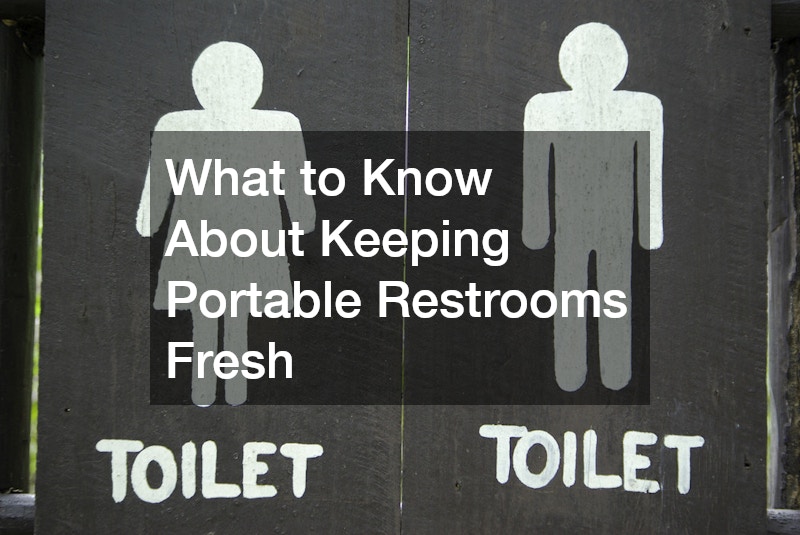Portable restrooms are a vital component of public and private events, construction sites, and remote locations where traditional sanitation facilities are unavailable. Maintaining their cleanliness and freshness is crucial for ensuring user satisfaction and hygiene. Whether you’re an event planner or a site manager, understanding these elements will aid in offering a better experience for everyone involved.
How Often Should Portable Restrooms Be Cleaned?
Determining the appropriate cleaning frequency for portable restrooms is critical to maintaining hygiene and user comfort. Depending on usage, restrooms at high-traffic events may require cleaning multiple times a day, while those at less frequented sites might need only weekly attention. A general guideline suggests cleaning should occur once for every 85 to 100 uses to ensure sanitary conditions. Consistent cleaning helps in the removal of waste, controlling odor, and replenishing necessary supplies like toilet paper and hand sanitizer. Adhering to a regular cleaning schedule prevents the buildup of germs and maintains a welcoming atmosphere for users.
Factors determining the cleaning frequency include the number of users, duration of the event or project, and local health regulations. Event organizers and project managers should assess these factors during planning to allocate sufficient resources for sanitation services. Inadequate cleaning not only causes unpleasant experiences but can also pose health risks due to the spread of bacteria and disease. High usage days, such as weekends at festivals or holidays on construction sites, demand more frequent attention.
What Cleaning Supplies are Essential?
Equipping portable restrooms with the right cleaning supplies is fundamental to maintaining freshness and hygiene. Essential cleaning supplies include disinfectants, deodorizing agents, mops, brushes, and gloves for personnel. Using high-quality, effective cleaning agents ensures thorough sanitation, eliminating harmful pathogens that can thrive in warm, moist conditions. Disinfectants specifically designed for restroom use can effectively kill germs and reduce the risk of cross-contamination. Alongside these, stock supplies such as toilet paper, hand soap, and hand sanitizer are indispensable for user satisfaction and health.
Deodorizing agents are crucial in combatting unpleasant odors that can develop in enclosed restroom spaces. These agents neutralize foul smells rather than merely masking them, playing a key role in maintaining a fresh environment. Businesses and event organizers should invest in environmentally friendly cleaning products to minimize environmental impact and ensure safety for both users and cleaning personnel. There are numerous eco-friendly options on the market that offer effective cleaning power while remaining gentle on the environment.
How Can Odors be Minimized in Portable Restrooms?
Controlling odors in portable restrooms is vital for user comfort and facility reputation. Odor management begins with regular cleaning and the use of specialized deodorizing agents that neutralize rather than mask bad smells. A key factor is the removal and proper disposal of waste, facilitated by frequent servicing. Another effective measure is the use of air fresheners and venting systems to circulate fresh air, preventing stagnant air that contributes to odor accumulation. Maintaining well-stocked supplies of deodorizing solutions and implementing regular ventilation can dramatically reduce the presence of unpleasant odors.
Placing portable restrooms in shaded, well-ventilated areas can also aid in minimizing odors. Heat tends to amplify smells, so keeping restrooms cool can contain and control odor levels. Many newer restroom models come equipped with advanced ventilation systems that enhance airflow, effectively reducing odor build-up. Regular user feedback can help identify problem areas and aid in adjusting deodorization methods accordingly. Consistent odor management not only ensures user satisfaction but also protects the reputation of service providers and event organizers.
What Role Does Maintenance Play in Freshness?
Regular maintenance is integral to keeping portable restrooms functional, sanitary, and fresh. It goes beyond cleaning and involves checking for and repairing any structural damages like leaks or broken locks. Routine maintenance ensures that all components of the restroom are operational, reducing downtime and enhancing user experience. By addressing minor issues promptly, facility managers can prevent them from becoming larger, more costly problems. Effective maintenance contributes to the longevity of the restroom units and saves costs in the long run by avoiding expensive replacements or repairs.
Maintenance also involves the consistent inspection of sanitation levels and waste management, adjusting services as needed. Conducting regular audits helps in maintaining high service standards and identifying areas for improvement. Companies providing portable restroom services should train their employees thoroughly, ensuring they’re capable of handling routine maintenance tasks efficiently. Additionally, keeping a detailed record of maintenance schedules and outcomes can assist in predicting future requirements and logistical planning. Quality maintenance ensures that restrooms not only remain functional but also presents a clean and welcoming environment to users.
Keeping portable restrooms fresh involves a multifaceted approach that encompasses regular cleaning, odor management, proper maintenance, and the use of essential supplies. Cleaning frequency and deodorization are crucial to maintaining a hygienic and pleasant environment for users. High-quality maintenance ensures that these restrooms remain functional and continue to serve high standards of sanitation. By adopting best practices, event organizers and site managers can guarantee user satisfaction and uphold public health standards. Commitment to maintaining clean and fresh portable restrooms reflects positively on all parties involved and contributes to successful events and projects.
.

